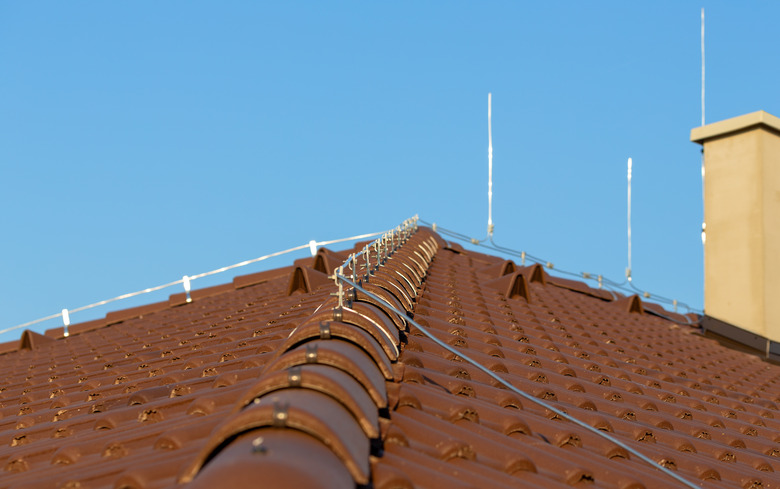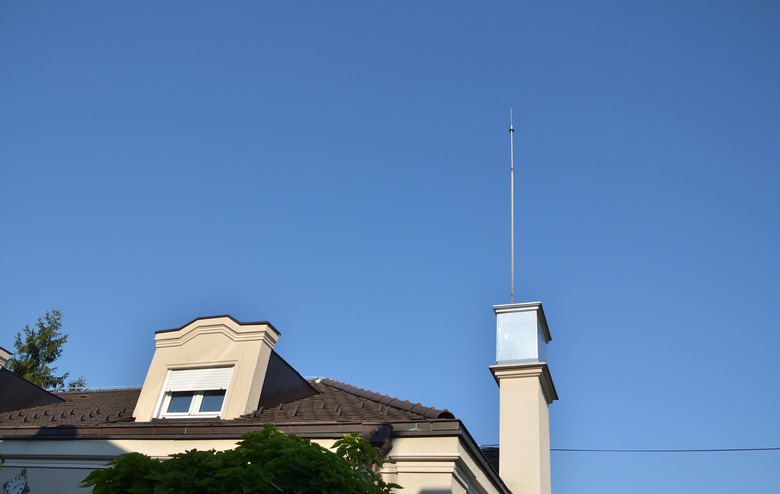How Do Lightning Rods Work — And Do I Need Them?
We may receive a commission on purchases made from links.
As the victim of about 25 lightning strikes a year, there's no question that the Empire State Building benefits from having lightning rods, which prevent the iconic landmark from being damaged by powerful lightning bolts. But while it's obvious that this famous New York City skyscraper needs lightning protection (lightning has a tendency to strike the tallest objects in a given area), it's much harder for the average homeowner to decide if they need lightning rods too. That answer varies depending on where you live and what kind of lightning protection you're seeking. Unfortunately, there is a lot of confusion about how a lightning rod works and how it's useful to a household.
When discussing lightning rods and lightning protection systems, it's important to note that every structure is different. Some homes, for example, need only one lightning rod, while larger homes may benefit from several lightning rods. The result is that the terms "rod" and "rods" are often used interchangeably. How many you need for your home is best determined by a lightning protection specialist.
Tip
Lightning rods work by simply providing the electricity of a lightning strike a low-resistance path to get to the ground where the electric charge can dissipate safely.
Your House and Lightning
Your House and Lightning
You know that bad things can happen if your house is struck by lightning, but you may not know just how bad. One of the biggest dangers of a lightning strike is the possibility of an electrical fire. Unfortunately, lightning can cause discrete fires of which you may not be immediately aware. For example, it's common for a lightning strike to start fires in attics, where homeowners may not notice them right away. (This is one more reason to install smoke detectors in your attic.)
Know too that lightning doesn't commit to taking a single pathway through your home. On its way to the ground, lightning that passes through your home can easily jump from one conductive item to another, easily moving from an electrical wire to a nearby plumbing pipe — and every jump creates another opportunity for a fire. If your house does get a direct strike, call the fire department right away to make sure you don't have fires you can't see burning inside your attic or walls.
If a lightning strike uses your electrical wiring as a conduit, which it likely will, lightning can also cause power surges that will destroy any electronics or appliances you have plugged in. It can even zap you if you so happen to be touching one of these appliances.
The more surprising lightning damage, however, comes from shock waves. When you hear thunder, you're actually hearing the sound of shock waves created by lightning. When lightning strikes a home, these shock waves can damage concrete, bricks and cinder blocks. Lightning shock waves have even reportedly blown out glass windows and plaster walls along with cracking home foundations.
What Lightning Rods Do
What Lightning Rods Do
A lightning strike can produce more than 100 million volts. Besides being a mind-blowingly high statistic, that kind of high-voltage power is extremely dangerous. It can produce a lot of heat, which can cause fires, and it can do a serious number on your home's electrical system.
Lightning rods are actually quite simple. They truly are a simple metal rod, often not much more than about 2 inches in diameter. The rod is connected to a wire made of a highly conductive material, typically copper. That wire runs down your home until it reaches the ground.
Buried underground is another metal rod known as the grounding rod. The wire from the lightning rod is attached to this grounding rod. Any electricity that a lightning strike generates is funneled through the lightning rod and down to the grounding rod, where it's diverted safely into the earth. If a building requires multiple lightning rods, they are linked together by wires known as bonding connectors.
Fortunately, electricity tends to take the path of least resistance. By providing this simple path to the ground, you can hopefully prevent a fire and protect your home's electrical system in the event of a lightning strike.
What Lightning Rods Don't Do
What Lightning Rods Don't Do
While lightning rods generally work quite well, they do have their limits. A jolt of 100 million volts or more is an incredible amount of power, and sometimes, they're unable to divert 100 percent of that power when they take a hit. This means that even with a lightning rod, it's possible that some of the electronic devices in your home could experience a power surge.
For this reason, experts often recommend installing a lightning rod as part of a larger lightning protection package. A full lightning protection system may include surge protection for incoming power, telephone and cable lines as well as gas lines. (Note that vulnerable appliances and electronics may require plug-in surge protection devices for extra protection.)
Another thing your lightning rod won't do is attract lightning. Think of the lightning rod as a soccer goalie. Your goalie doesn't attract the soccer ball to the goal, but the goalie will jump in front of a ball that is already headed that way. Lightning rods don't attract lightning strikes, but they will take a hit for the team if a lightning strike is already headed toward your house.
Lightning Rod Pros and Cons
Lightning Rod Pros and Cons
The very best thing about lightning rods is that they protect your home. A close second benefit, however, is the appearance of modern hardware. Today's lightning rods are shorter and more discrete than those of the past, so you can install lightning protection without ruining your home's curb appeal.
Lightning protection systems are also customizable. A qualified installer can assess your home and determine how many lightning rods you need and what other added protections would benefit you. This personalized planning can offer you excellent protection against lightning strikes and may even save you some money on your homeowners' insurance. Sometimes, insurance companies offer discounts or credit to those with professionally installed lightning protection systems.
However, installing lightning rods is absolutely not a DIY project. Get it wrong and a lightning rod can become a danger instead of offering protection. In other words, this is not the time to try to avoid a professional's fee and save a buck.
This leads to the next lightning rod con, which is cost. On average, homeowners pay about $1,500 for a lightning rod installation. Your house may need more than one rod, however, and extras, like a whole-house surge protector, can easily add $300 to $500 to your lightning rod system costs.
Do You Need a Lightning Rod?
Do You Need a Lightning Rod?
The answer to this question depends largely on where you live. The Southeastern United States sees more lightning than other parts of the country. In 2019, Florida, Oklahoma, Missouri and Texas were the states with the densest lightning hits. If you live in an area prone to lightning strikes, a lightning rod may be a good idea.
You may also wish to consider installing lightning rods and other protections if your home is taller than the buildings around it. A rod is also a good idea if you have trees within 10 feet of your home that are taller than your house. Unfortunately, trees sometimes catch fire when struck by lightning or can split, which can cause branches to crash down onto your roof, potentially causing damage. It's generally safer to install a lightning rod than to count on nearby trees for protection.
While location is important when deciding whether to install a lightning rod, so are the things you might lose during a lightning strike, and particularly things that require an electrical charge. No one wants to replace a computer that got zapped during a lightning storm, but you'll be even more distressed if a lightning hit takes out a more expensive item, such as your electric car. You can, of course, unplug expensive appliances during a storm, but you can't do that if you're away from home when a storm strikes.
Roofing materials can play a role as well — metal roofs, for instance, are no more likely to attract lightning than other roofing materials. They are, however, much less likely to catch fire if hit. If your primary concern is fire protection, you may not need a lightning rod on a metal roof. If your larger concern is protecting the electrical devices in your home, you may opt for a lightning rod even with a metal roof.
References
- Empire State Building: Facts & Figures
- National Weather Service: Lightning Rods
- Vaisala: Year of Thunder and Lightning – Annul Lightning Report 2019
- Lightning Protection Institute: Frequently Asked Questions
- HomeAdvisor: How Much Does It Cost To Install A Home Lightning Protection System?
- ValChoice: Does My Home Need a Lightning Rod to Protect From Lightning Strikes?
- NY1: How Our Tallest Buildings Handle Lightning Strikes

